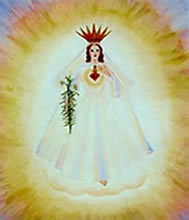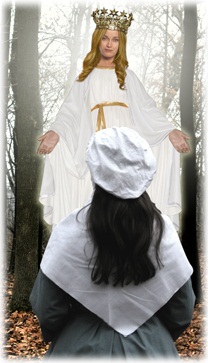 Yesterday’s news reports that Our Lady of Good Help had just become America’s first approved apparition caused many folks to do a doubletake.
Yesterday’s news reports that Our Lady of Good Help had just become America’s first approved apparition caused many folks to do a doubletake.
Some wondered whether Our Lady of Guadalupe should count as such since Mexico is part of North America. If one wants to say that Guadalupe was North America’s first approved apparition, fine. However, one can’t say Guadalupe was “America’s” first approved apparition since, when used in the singular, “America” refers to the United States of America. The continent Mexico is part of is “North America,” and the overall landmass that includes “South America” is known as “the Americas” (plural, with the definite article).
But enough linguistic hairsplitting!
Others had the question, “What about Our Lady of America? Wasn’t that already approved?”
The short but understandably surprising answer is “no.” It’s not approved.
“But didn’t then-Archbishop/now-Cardinal Raymond Burke issue a letter in 2007 that said it was approved?”
Again, the short but understandably surprising answer is “no.” He didn’t.
The reason that the answer is understandably surprising is that he did in 2007 send a letter to the U.S. bishops explaining Our Lady of America, speaking highly of it, and noting that the devotion connected with it has been approved, but this is not the same as saying that apparition itself is approved.
Am I just linguistic hairsplitting again?
Not according to the Holy See—or, more specifically, the Congregation for the Doctrine of the Faith. I’m actually articulating a point that the CDF wants people to understand.
Lemme ‘splain.
Back in 1978 the CDF issued an instruction on apparitions which was privately (sub secreto) circulated to the bishops of the world. Because it was so widely circulated, it was leaked, which means that now you can read a copy of it in English here. These represent the norms currently in force to guide bishops in dealing with apparitions.
So what do the norms say?
A key passage describes a three-stage process that apparition approval is to follow (assuming the approval happens at all; the process can be aborted at any stage):
So that the ecclesiastical authority is able to acquire more certainty on such or such an apparition or revelation, it will proceed in the following way:
a) Initially, to judge the facts according to positive and negative criteria (cf. below, n.1).
b) Then, if this examination appears favorable, to allow certain public demonstrations of cult and devotion, while continuing to investigate the facts with extreme prudence (which is equivalent to the formula: “for the moment, nothing is opposed to it”).
c) Finally, after a certain time, and in the light of experience, (starting from a particular study of the spiritual fruits generated by the new devotion), to give a judgement on the authenticity of the supernatural character, if the case requires this.
Stage 1 is thus for the bishop to do an initial investigation. If that checks out then in Stage 2 he may provisionally authorize public demonstrations of cult and devotion in connection with the apparition while continuing a diligent examination. Then, after more time and investigation, should the circumstances warrant, he may in Stage 3 approve the apparition itself.
The final Stage 3 approval of the apparition is distinct from the provisionary Stage 2 authorization of public devotion. That is why the CDF norms gloss this authorization by saying it is equivalent to “for the moment, nothing is opposed to it.”
“For the moment, nothing is opposed to it” is not the same as what Bishop Ricken said yesterday concerning Our Lady of Good Help, which was:
It remains to me now, the Twelfth Bishop of the Diocese of Green Bay and the lowliest of the servants of Mary, to declare with moral certainty and in accord with the norms of the Church:
that the events, apparitions and locutions given to Adele Brise in October, 1859 do exhibit the substance of supernatural character, and I do hereby approve these apparitions as worthy of belief (although not obligatory) by the Christian faithful.
That’s a Stage 3 approval: The apparition itself, not just devotion connected with it, has been recommended to the faithful as worthy of (non-obligatory) belief.
So what is the status of Our Lady of America?
Basically, it’s at Stage 2—the same stage that Our Lady of Good Help was at until December 8th. Some years ago the local bishop (who was himself the seer’s former spiritual director) authorized devotion connected with Our Lady of America, and granted an imprimatur to a book connected with it (which is a totally separate issue, canonically), but neither previous local bishops nor the current local bishop has given Stage 3 authorization to the apparition itself.
If you read now-Cardinal Burke’s letter carefully (you can read it here), he is careful always to speak of the devotion having been approved. He never says that the apparition itself has been approved.
That’s because of its Stage 2 status. The local bishop (who was not Burke; this was when Burke was Archbishop of St. Louis, but the Our Lady of America phenomena were reported in the dioceses of Fort Wayne and Toledo) had not proceeded to Stage 3. Burke is thus giving an interesting and supportive treatment of the apparition and the devotion connected with it, but he only claims formal approval for the devotion.
This distinction is one that the CDF wants the public to understand because a little later on in the norms it has more to say about Stage 2 situations. Section II, 2 of the document states:
At the legitimate request of the faithful (when they are in communion with their pastors and are not driven by a sectarian spirit), the competent ecclesiastical Authority can intervene to authorize and promote various forms of worship and devotion if, assuming the criteria given above having been applied, nothing is opposed to it. But there must be vigilance nevertheless, to ensure that the faithful do not regard this way of acting as an approval by the Church of the supernatural character of the event in question. . . .
So the distinction between Stage 2 approval (of devotion related to the apparition) and Stage 3 approval (of the supernatural character of the apparition) is something that the CDF itself wants the public to understand.
Presumably, the CDF expects bishops granting Stage 2 approval to stress the difference between the two, so that the public understands.
It is evident from the confusion in this case, though, that more work needs to be done in alerting the public to this difference.
BTW, in his letter on Our Lady of America Cardinal Burke alludes to some question of the canonical status of a “community” (actually, it appears to be just one person) promoting Our Lady of America. He rightly notes that the status of this community is a separate canonical question from whether the devotion has been approved. But this passage in his letter is bound to raise curiosity about what the issues are connected with this community and what the current local bishops’ stand is. Therefore . . .
HERE’S A STATEMENT FROM THE DIOCESE OF TOLEDO ON THE SITUATION
What are your thoughts?

